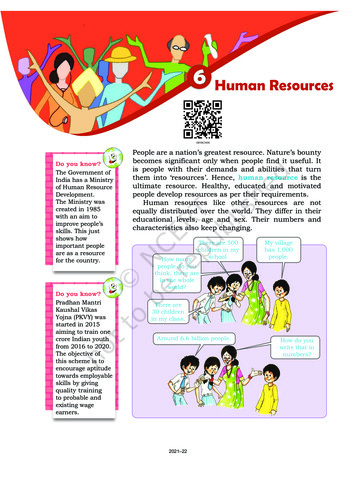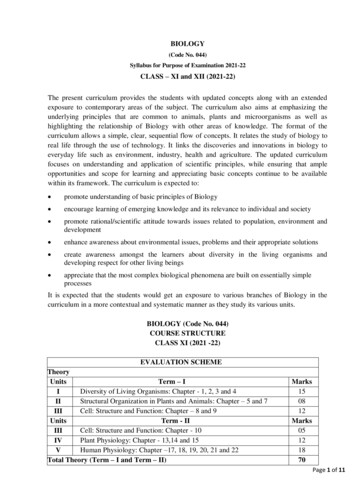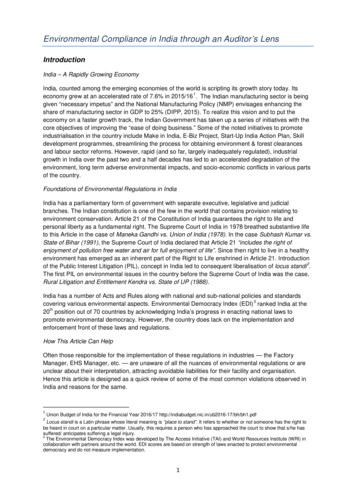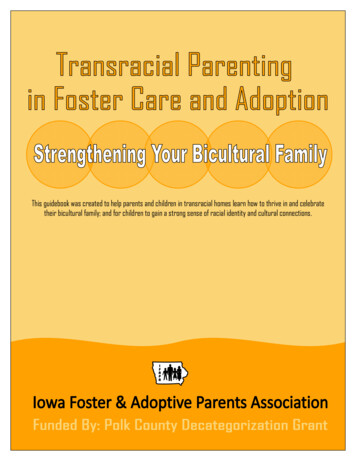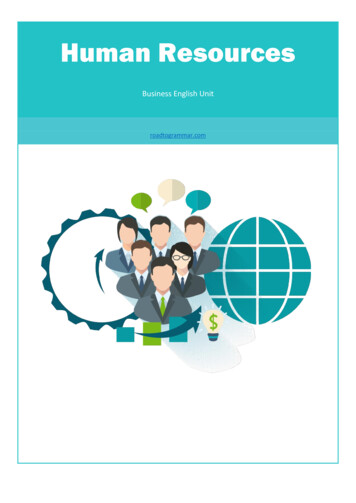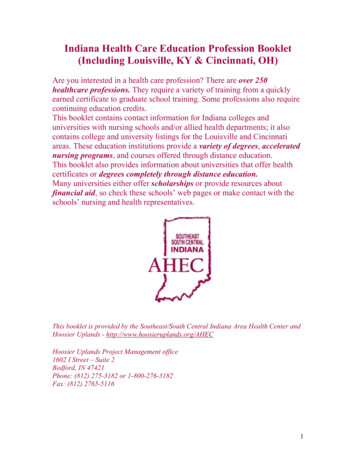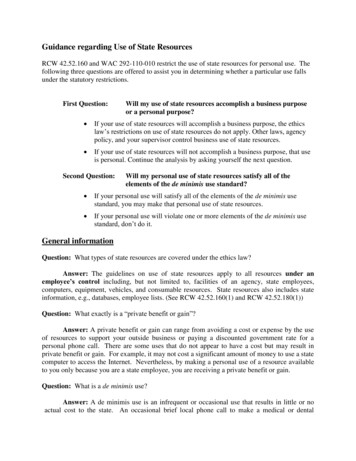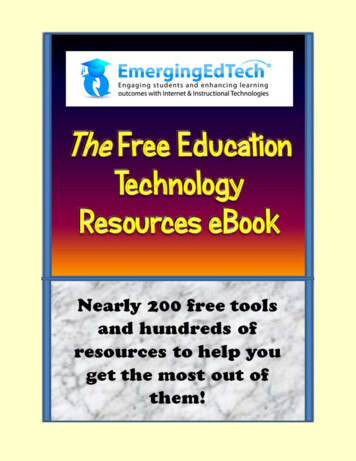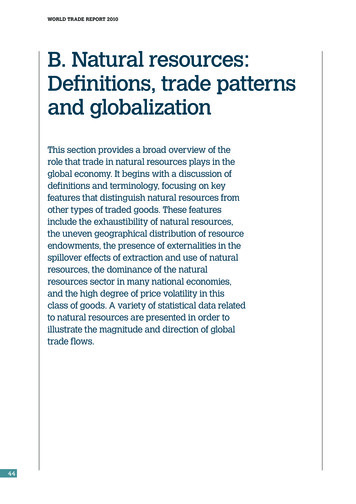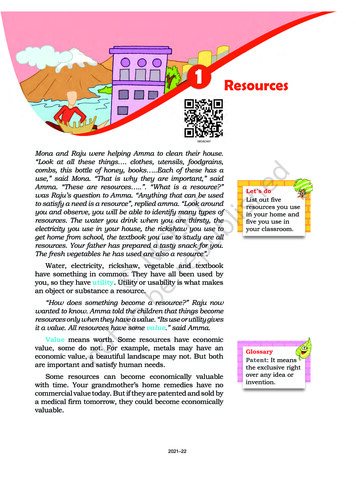
Transcription
ResourcesMona and Raju were helping Amma to clean their house.“Look at all these things . clothes, utensils, foodgrains,combs, this bottle of honey, books .Each of these has ause,” said Mona. “That is why they are important,” saidAmma. “These are resources .”. “What is a resource?”was Raju’s question to Amma. “Anything that can be usedto satisfy a need is a resource”, replied amma. “Look aroundyou and observe, you will be able to identify many types ofresources. The water you drink when you are thirsty, theelectricity you use in your house, the rickshaw you use toget home from school, the textbook you use to study are allresources. Your father has prepared a tasty snack for you.The fresh vegetables he has used are also a resource”.Let’s doList out fiveresources you usein your home andfive you use inyour classroom.Water, electricity, rickshaw, vegetable and textbookhave something in common. They have all been used byyou, so they have utility. Utility or usability is what makesan object or substance a resource.“How does something become a resource?” Raju nowwanted to know. Amma told the children that things becomeresources only when they have a value. “Its use or utility givesit a value. All resources have some value.” said Amma.Value means worth. Some resources have economicvalue, some do not. For example, metals may have aneconomic value, a beautiful landscape may not. But bothare important and satisfy human needs.Some resources can become economically valuablewith time. Your grandmother’s home remedies have nocommercial value today. But if they are patented and sold bya medical firm tomorrow, they could become economicallyvaluable.2021–22GlossaryPatent: It meansthe exclusive rightover any idea orinvention.
GlossaryTechnology: It isthe application oflatest knowledgeand skill in doingor making things.ActivityCircle thoseresources fromAmma’s list thatare regardedas having nocommercial value.Time and technology are two important factors thatcan change substances into resources. Both are relatedto the needs of the people. People themselves are themost important resource. It is their ideas, knowledge,inventions and discoveries that lead to the creation ofmore resources. Each discovery or invention leads to manyothers. The discovery of fire led to the practice of cookingand other processes while the invention of the wheelultimately resulted in development of“A verynewer modes of transport. The technologyvaluable one!”to create hydroelectricityhas turned energy in fast“So I am aflowing water into an resource too!”important resource.TypesofResourcesResources are generally classified intonatural, human made and human.Amma’s ListCotton clothIron oreIntelligenceMedicinal plantsMedical knowledgeCoal depositsBeautiful sceneryAgricultural landClean environmentOld folk songsGood weatherResourcefulnessA good singing voiceGrandmother’shome remediesAffection fromfriends and family2ResourcesandNatural ResourcesResources that are drawn from Nature and used withoutmuch modification are called natural resources. Theair we breathe, the water in our rivers and lakes, thesoils, minerals are all natural resources. Many of theseresources are free gifts of nature and can be used directly.In some cases tools and technology may be needed touse a natural resource in the best possible way.Natural resources can be broadly categorised intorenewable and non-renewable resources.Renewable resources are those which get renewedor replenished quickly. Some of these are unlimitedand are not affected by human activities, such as solarand wind energy. Yet careless use of certain renewableresources like water, soil and forest can affect theirstock. Water seems to be an unlimited renewableresource. But shortage and drying up of naturalwater sources is a major problem in many parts of theworld today.Non-renewable resources are those which have alimited stock. Once the stocks are exhausted it maytake thousands of years to be renewed or replenished.Since this period is much more than human life spans,Development2021–22
such resources are considered non-renewable. Coal,petroleum and natural gas are some examples.The distribution of natural resources dependsupon number of physical factors like terrain, climateand altitude. The distribution of resources is unequalbecause these factors differ so much over the earth.GlossaryStock of ResourceIt is the amount ofresources availablefor use.Human Made ResourcesSometimes, natural substances become resources onlywhen their original form has been changed. Iron orewas not a resource until people learnt to extract ironfrom it. People use natural resources to make buildings,bridges, roads, machinery and vehicles, which areknown as human made resources. Technology is alsoa human made resource.“So people like us use natural resources to make humanmade resources,” said Mona nodding in understanding.“Yes,” said Raju.Human ResourcesPeople can make the best use of nature to create moreresources when they have the knowledge, skill and the“Crops ruineddue todrought”.“Can I finda solution?”.that’s it!“ its all thanksto the knowledge,education andskill we could finda solution Read and Ponder: Humans are interdependent oneach other. Farmers provide food grains for every one.Scientists suggest various means to combat problemsrelated to agriculture and improve farm production.Let’s doThink of a fewrenewable resourcesand mention howtheir stock may getaffected by overuse.Let’s doMake a list offive human maderesources that youcan observe aroundyou.Do you know?Human Resourcerefers to thenumber (quantity)and abilities(mental andphysical) of thepeople. Though,there are differingviews regardingtreatment ofhumans as aresource, onecannot deny thefact that it is theskills of human thathelp in transferingthe physicalmaterial into avaluable resource.Resources2021–223
technology to do so. That is why humanbeings are a special resource. Peopleare human resources. Education andhealth help in making people a valuableresource. Improving the quality ofpeople’s skills so that they are ableto create more resources is known ashuman resource development.Conserving ResourcesMona had a nightmare. She dreamt that allthe water on the earth had dried up and all thetrees cut down. There was no shade and nothing toeat or drink. People were suffering and roaming arounddesperately looking for food and shade.She told her mother about the dream. “Amma can thisreally happen?” she asked.GlossarySustainableDevelopmentCarefully utilisingresources so thatbesides meetingthe requirementsof the present, alsotakes care of futuregenerations.“Yes,” Amma replied. “If we are not careful then evenrenewable resources can become very scarce and thenon-renewable ones can definitely get exhausted”. “Whatcan we do about it,” Raju asked. “Lots,” replied Amma.Using resources carefully and giving them time to getrenewed is called resource conservation. Balancingthe need to use resources and also conserve them forthe future is called sustainable development. Thereare many ways of conserving resources. Each personcan contribute by reducing consumption, recycling andreusing thing. Ultimately it makes a difference becauseall our lives are linked.That evening the children and their friendsmade packets and shopping bags out of oldnewspapers, discarded clothes and basketsfrom bamboo sticks. “We will give a few to everyfamily we know,” said Mona. “After all it is fora very good cause,” said Mustafa, “To save ourresources and to keep our earth alive”.“I am going to be very careful not to wastepaper,” said Jessy. “Many trees are cut down tomake paper,” she explained.“I will see that electricity is not wasted inmy house,” shouted Mustafa. “Electricity comesfrom water and coal.”4ResourcesandDevelopment2021–22
“I will make sure that water is not wasted at home,” Some Principles ofsaid Asha. “Every drop of water is precious”Sustainable Development“Together we can make a difference!” chorused thechildren.These are some of the things Mona, Raju and theirfriends did. What about you? How are you going to helpin conserving resources?The future of our planet and its people is linked withour ability to maintain and preserve the life supportsystem that nature provides. Therefore it is our duty toensure that : all uses of renewable resources are sustainable the diversity of life on the earth is conserved the damage to natural environmental system isminimised.Respect and care for allforms of lifeImprove the quality ofhuman lifeConserve the earth’svitality and diversityMinimise the depletionof natural resourcesChange personalattitude and practicestowards the environmentEnable communitiesto care for their ownenvironment.Exercises1. Answer the following questions.(i) Why are resources distributed unequally over the earth?(ii) What is resource conservation?(iii) Why are human resources important?(iv) What is sustainable development?2. Tick the correct answer.(i) Which one of the following does NOT make substance a resource?(a) utility(b) value(c) quantity(ii) Which one of the following is a human made resource?(a) medicines to treat cancer(b) spring water(c) tropical forests(iii) Complete the statement.Non-renewable resources are(a) those which have limited stock(b) made by human beings(c) derived from non-living things3. Activity“Rahiman paani raakhiye,Bin paani sab soon.Resources2021–225
Paani gaye na ubereMoti, manus, choon ”[Says Rahim, keep water, as without water there is nothing. Without waterpearl, swan and dough cannot exist. ]These lines were written by the poet Abdur Rahim Khankhana, one of thenine gems of Akbar’s court. What kind of resource is the poet referring to?Write in 100 words what would happen if this resource disappeared?For Fun1. Pretend that you live in the prehistoric times on a high windy plateau. Whatare the uses you and your friends could put the fast winds to? Can you callthe wind a resource?Now imagine that you are living in the same place in the year 2138. Canyou put the winds to any use? How? Can you explain why the wind is animportant resource now?2. Pick up a stone, a leaf, a paper straw and a twig. Think of how you can usethese as resources. See the example given below and get creative!You can use a stone Use/UtilityTo play stapuAs a paper-weightTo crush spicesTo decorate your garden/roomTo open a bottleIn a catapulttoytooltooldecoration piecetoolweaponUse/UtilityYou can use a leaf 6ResourcesandDevelopment2021–22
Human Made Resources . Sometimes, natural substances become resources only . when their original form has been changed. Iron ore was not a resource until people learnt to extract iron from it. People use natural resources to make buildings, bridges, roads, machinery and vehicles, which are known as . human
